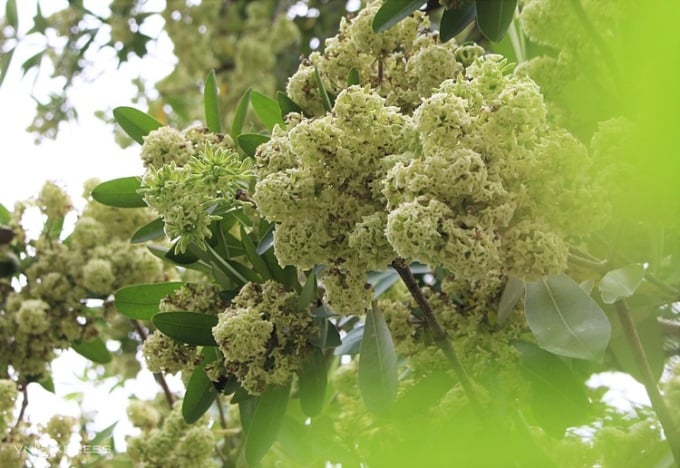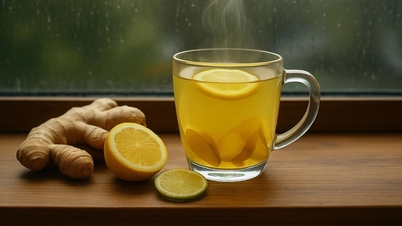Milk flower has the ability to cause high allergies, especially pollen, creating an uncomfortable feeling for people standing nearby, but many parts of this plant are medicinal in Oriental medicine.
General practitioner Bui Dac Sang, Academy of Science and Technology, Hanoi Oriental Medicine Association, said that the scientific name of the milk flower is Alstonia scholaris, oleander family (Apocynaceae). The reason the plant is called "milk flower" is because when damaged, the whole plant exudes a milky white sap.
Milk flower is grown and grows wild in our country, especially in the northern provinces. This is a woody plant, average height 15-30 m, round, straight stem, brown outer bark, cracked, inside contains a lot of white resin. Leaves grow in circles, long oval blade, leaves about 5.5-6.5 cm wide and 8-22 cm long. Flowers grow in clusters, at the end of branches, white or light green, with a characteristic fragrance.
According to physician Sang, milk flower has a high potential to cause allergies, especially pollen. The scent of milk flower is very strong in nature, if smelled a little, standing from a distance with a faint fragrance, it feels pleasant. However, when standing close or smelling for a long time, the fragrance can rush into the nose, causing discomfort to people with sensitive constitutions, especially those with a history of respiratory diseases. In addition, the hairs or pollen of milk flower mixed with the wind into the air, people inhale can also easily cause allergies, affecting health.
Therefore, people with respiratory diseases, allergic rhinitis, sinusitis, allergic conjunctivitis should avoid using this medicine. People with allergies will have itching, acne, rashes due to milk pollen, which are allergens that trigger allergies. When milk flowers bloom, many people also have headaches and dizziness.

Milk flower is considered one of the memorable things about autumn in Hanoi , despite causing much controversy about its scent. Photo: Huynh Nhi
Although the milk flower can easily cause allergies, some parts of the plant are medicinal in Oriental medicine. The bark contains some chemical components such as echitenin and ditamin, which are used to make medicine. The milk flower medicine has a bitter taste, cool properties, and the effect of eliminating phlegm, detoxifying, and regulating menstruation; it is used to treat menstrual disorders, as a health tonic, to treat acute and chronic malaria, skin itching, high fever, anemia, dysentery, diarrhea, and arthritis. In India, the milk flower is used to treat dental diseases due to its antibacterial effects.
According to modern pharmacological research, milk flower helps fight inflammation, reduce coughs, asthma and pain. Methanol in milk flower leaves can fight alpha-glucoside, potential prevention and treatment of diabetes. Alkaloids in milk flower have the effect of fighting cancer cells and increasing the survival of experimental mice. In addition, milk flower also has the effect of treating digestive disorders.
Physician Sang notes that when using the milk flower tree to treat diseases, avoid confusing it with the star apple tree. In addition, using milk tree bark in high doses can be toxic, so do not use it on your own but consult a specialist, appropriate to the condition of the disease.
Experts also recommend that people, especially those with respiratory problems or allergies, should limit or avoid direct contact with the scent, pollen and hair of the milk flower.
Thuy Quynh
Source link




![[Photo] Prime Minister Pham Minh Chinh chairs the 16th meeting of the National Steering Committee on combating illegal fishing.](https://vphoto.vietnam.vn/thumb/1200x675/vietnam/resource/IMAGE/2025/10/07/1759848378556_dsc-9253-jpg.webp)





![[E-Magazine]: That place is so passionate that it makes your heart flutter](https://vphoto.vietnam.vn/thumb/402x226/vietnam/resource/IMAGE/2025/8/22/ac7c83ddf6dc43a49a177f8f8bc2262d)

























![[Photo] Super harvest moon shines brightly on Mid-Autumn Festival night around the world](https://vphoto.vietnam.vn/thumb/1200x675/vietnam/resource/IMAGE/2025/10/07/1759816565798_1759814567021-jpg.webp)































































Comment (0)